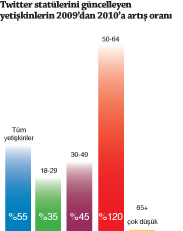Dünyanın Bütün Yaşlıları Bir Gün Sosyal Medyada Birleşecek mi?
Brands have made long-term investments in the world's young age groups, who have no sense of loyalty for years. However, social media use is not as young as it is thought.
In the early 2000s, when I said that the internet would be of interest to older age groups rather than young people in the future, I received a negative reaction from everyone around me. Today, this prediction of mine has been more than confirmed in the United States. The performance of older age groups in this country on social media has reached a level where brands need to welcome them in this environment. FLOWTOWN.COM, one of the platforms that reveals social media performance, has announced the demographic characteristics of social media in the United States. The study conducted by FLOWTOWN.COM reveals that among internet users integrated into social media in the United States, the highest performance is shown by people aged 50 and above. It is a theory today that the internet is a much more ideal environment for older age groups than young people worldwide. However, social media has come to mean a lot to people aged 50 and above by presenting product features that can turn this theory into practice in the United States. According to the results presented by FLOWTOWN.COM; In the United States, the performance of social media users by age group in September 2005 is as follows: 16% of the 18-29 age group, 12% of the 30-49 age group, 7% of the 50-64 age group and 5% of those over the age of 65 use social media. According to the research, by May 2010; 86% of the 18-29 age group, 61% of the 30-49 age group, 47% of the 50-64 age group and 26% of those over the age of 65 started using social media. If we look at the increase rates during this period; the 18-29 age group started using social media with a 5.37-fold increase, the 30-49 age group with a 5.08-fold increase, the 50-64 age group with a 6.71-fold increase and those over the age of 65 with a 5.2-fold increase. As FLOWTOWN.COM also stated, the highest rate of participation in social media among age groups belongs to the 50-64 age group. If we put the increase rates aside; we see that one in every two internet users in the 50-64 age group and one in every four internet users over the age of 65 in the United States use social media. This is an incredible result and will soon show its effect all over the world, not just in the United States. However, according to COMSCORE data, 88% of internet users in Turkey today are in the 15-44 age group. When we look at older age groups; the rate of internet users over the age of 45 is 12% and the internet usage rate of people over the age of 55 is only 2%. However, based on the same COMSCORE data, we know that 95% of internet users in Turkey use social media. Therefore, in Turkey, as internet usage increases in older age groups, social media usage will also increase, and just like in the United States,It won’t take long for us to see that the internet in Turkey is not a place where a handful of young people have fun. As for the future impact of the performance trend of older age groups on brands… First of all, brand loyalty is higher in older age groups than in younger people. This situation will have extremely important results in terms of both social media usage and loyalty to brands that appear on social media. On the other hand, older age groups are more stable and disciplined than younger people. In fact, it is this stability and discipline that brings about their relative brand loyalty. Again, this age group is a much bigger world than the pocket money world in economic terms. Their regular income and the savings they have made over the years in addition to their regular income are much higher.
 It is enough to look at the table above to see that older age groups are more stable and disciplined than younger ones. As can be seen in this table, the highest growth rate in updating Twitter statuses in the United States belongs to the 50-64 age group.
It is enough to look at the table above to see that older age groups are more stable and disciplined than younger ones. As can be seen in this table, the highest growth rate in updating Twitter statuses in the United States belongs to the 50-64 age group.
 For years, brands have made long-term investments in young age groups that have no sense of loyalty. In many examples I have experienced, I have seen brand managers banging their heads against walls (!) because they could not get a return on these long-term investments made in young people. Here is a great opportunity in interactive marketing. With the power of the greatest capital called life experience and accumulation, older age groups will be waiting for you on social media to transfer their income to brands. This is definitely one of the trends we should be observing starting from 2011. I claim that within 5 years at most, many industries that are considered to appeal to young people, such as ready-made clothing, entertainment, automotive and technology markets, will receive a great return on the investment they will make in older age groups in interactive media. ole777 In short, using social media is not as young as it is thought to be. The average age of people using social media in the United States is 37. The average age of LinkedIn users is 44, the average age of MySpace users is 31, the average age of Facebook users is 38 (and 60% of Facebook users are over 35), and the average age of Twitter users is 39 (and 64% of Twitter users are over 35). Needless to say, all the elderly in the world will unite on social media in the near future. With this article, I wish all brands “Brand Health” in 2011.
SOURCES USED FOR FIGURES AND TABLES: http://www.flowtown.com/blog/older-people-flocking-to-social-networks?display=wide http://www.webrazzi.com/2010/11/09/webrazzi-summit-sunumlari/
For years, brands have made long-term investments in young age groups that have no sense of loyalty. In many examples I have experienced, I have seen brand managers banging their heads against walls (!) because they could not get a return on these long-term investments made in young people. Here is a great opportunity in interactive marketing. With the power of the greatest capital called life experience and accumulation, older age groups will be waiting for you on social media to transfer their income to brands. This is definitely one of the trends we should be observing starting from 2011. I claim that within 5 years at most, many industries that are considered to appeal to young people, such as ready-made clothing, entertainment, automotive and technology markets, will receive a great return on the investment they will make in older age groups in interactive media. ole777 In short, using social media is not as young as it is thought to be. The average age of people using social media in the United States is 37. The average age of LinkedIn users is 44, the average age of MySpace users is 31, the average age of Facebook users is 38 (and 60% of Facebook users are over 35), and the average age of Twitter users is 39 (and 64% of Twitter users are over 35). Needless to say, all the elderly in the world will unite on social media in the near future. With this article, I wish all brands “Brand Health” in 2011.
SOURCES USED FOR FIGURES AND TABLES: http://www.flowtown.com/blog/older-people-flocking-to-social-networks?display=wide http://www.webrazzi.com/2010/11/09/webrazzi-summit-sunumlari/
Anasayfa'ya Dön
 It is enough to look at the table above to see that older age groups are more stable and disciplined than younger ones. As can be seen in this table, the highest growth rate in updating Twitter statuses in the United States belongs to the 50-64 age group.
It is enough to look at the table above to see that older age groups are more stable and disciplined than younger ones. As can be seen in this table, the highest growth rate in updating Twitter statuses in the United States belongs to the 50-64 age group.
 For years, brands have made long-term investments in young age groups that have no sense of loyalty. In many examples I have experienced, I have seen brand managers banging their heads against walls (!) because they could not get a return on these long-term investments made in young people. Here is a great opportunity in interactive marketing. With the power of the greatest capital called life experience and accumulation, older age groups will be waiting for you on social media to transfer their income to brands. This is definitely one of the trends we should be observing starting from 2011. I claim that within 5 years at most, many industries that are considered to appeal to young people, such as ready-made clothing, entertainment, automotive and technology markets, will receive a great return on the investment they will make in older age groups in interactive media. ole777 In short, using social media is not as young as it is thought to be. The average age of people using social media in the United States is 37. The average age of LinkedIn users is 44, the average age of MySpace users is 31, the average age of Facebook users is 38 (and 60% of Facebook users are over 35), and the average age of Twitter users is 39 (and 64% of Twitter users are over 35). Needless to say, all the elderly in the world will unite on social media in the near future. With this article, I wish all brands “Brand Health” in 2011.
SOURCES USED FOR FIGURES AND TABLES: http://www.flowtown.com/blog/older-people-flocking-to-social-networks?display=wide http://www.webrazzi.com/2010/11/09/webrazzi-summit-sunumlari/
For years, brands have made long-term investments in young age groups that have no sense of loyalty. In many examples I have experienced, I have seen brand managers banging their heads against walls (!) because they could not get a return on these long-term investments made in young people. Here is a great opportunity in interactive marketing. With the power of the greatest capital called life experience and accumulation, older age groups will be waiting for you on social media to transfer their income to brands. This is definitely one of the trends we should be observing starting from 2011. I claim that within 5 years at most, many industries that are considered to appeal to young people, such as ready-made clothing, entertainment, automotive and technology markets, will receive a great return on the investment they will make in older age groups in interactive media. ole777 In short, using social media is not as young as it is thought to be. The average age of people using social media in the United States is 37. The average age of LinkedIn users is 44, the average age of MySpace users is 31, the average age of Facebook users is 38 (and 60% of Facebook users are over 35), and the average age of Twitter users is 39 (and 64% of Twitter users are over 35). Needless to say, all the elderly in the world will unite on social media in the near future. With this article, I wish all brands “Brand Health” in 2011.
SOURCES USED FOR FIGURES AND TABLES: http://www.flowtown.com/blog/older-people-flocking-to-social-networks?display=wide http://www.webrazzi.com/2010/11/09/webrazzi-summit-sunumlari/
YORUM YAZIN
Max. 255 karakter girebilirsiniz
Yorumunuz Alınıyor
Boş Yorum Gönderemezsiniz


YORUMLAR
Hiç Yorum Yok